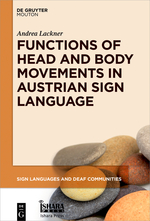Publikationen
Ausgewählte Publikationen
Most Characteristic Elements of Sign Language Texts Are Intricate Mixtures of Linguistic and Non-linguistic Parts, Aren’t They?
There is a considerable number of sign language linguists who accept as proven that essential parts of sequential-simultaneous constructions in sign languages (henceforth: SL) are “gestural” and therefore do not have language status, i.e. are “non-linguistic”. This judgement applies to all elements of SL where spatial parameters are used to code indexical and iconic meanings or spatial relations. The respective argumentations contain many methodologically questionable steps and are particularly led by a strong bias towards a spoken language (henceforth: SpL) perspective. This bias includes an uncritical adoption of the results of research on gestures to SL (“uncritical” means that the inconsistencies in gesture research itself were not considered); despite the fact that gesture research was performed exclusively on SpL. Therefore, a discussion of the assumptions and analysis processes concerning SL is urgent. In order to overcome the SpL bias in SL linguistics we need a typological model which takes both SpL and SL as instances of “language” in different modalities. By abstracting from both types of language, a new extended model of “language” can be developed.I will perform my analysis from the perspective of a typological language model which comprises both SL and SpL in equal measure. A comprehensive typology assumes that every language shows those categories which its users select as the best suited for the chosen modality or modalities. It cannot devaluate visually appropriate ones against acoustically appropriate ones. By this I want to prove that the assumption of an enormous number of gestural components in SL texts, intricately combined with language elements – concerning essential areas of SL grammar – is untenable.The methodological shortcomings of the “Gesture School” to be indicated are: The authors neither apply a modality-independent model of language, nor transfer “gradience” and “conventionalisation” to SL conformly to typology and semiotics. Additionally, we find no consideration of: * the coding conditions and possibilities of SL, especially related to indexical and iconic (in contrast to symbolic) morphemes * the relation between gradient production and categorical cognitive processing in all languages * the contrast between listability and the application of rules (by inadequate application of the listability criterion against SL morphemes like classifiers, ignoring the existing grammatical rules for them).
Teaching the National Written Language to Deaf Students: A New Approach
Deaf people across Europe struggle to have equal access to written Information as the main language of instruction in school is the spoken language. The "Deaf Learning" project (2015-1-PL01-KA204-016) aims at improving the above-mentioned situation by developing a face-to-face course supported by a Moodle course according to the needs of young deaf adults. Within the project, the partners developed a framework for lessons ranging from A1 to B2 (on the basis of the Common European Framework for Languages, CEFR) to improve reading and writing skills in the respective national languages. The teaching materials for level A1 consist of 30 lessons in pdf printable version, and 6 Moodle lessons. To make the course suitable for the very heterogeneous group of deaf learners, the structure of the lessons was designed so that teachers can adapt it to the needs of the deaf students. The Moodle lessons are kept simple and visual; they include sign language videos, images, and H5P interactive contents. The teaching materials have been tested in Italy for the main target group (17 participants aged 16-25 years) and in Austria for all other interested parties (3 participants aged over 30 years) through face-to-face lessons. The participants' feedback was incorporated into the materials.
„Deaf Learning“: Using A Visual Method to Teach Written Language to The Deaf
The majority of deaf people prefer to use the visual channel for communication, choosing a national sign language instead of a spoken language. In many countries, Deaf education is still not bilingual, therefore deaf people frequently have problems with learning and using the written language of their country. The Erasmus+ project "Deaf Learning" addresses the need for a visually-oriented written language course for the levels from A1 to B2. The main target group is that of young deaf adults aged 16 to 25 years. A secondary target group are older deaf people who are interested in improving their written language competence.
Gebärden als Kommunikationsmittel
Grundzweck der menschlichen Kommunikation ist es, mit anderen Menschen in sozialen Kontakt zu treten und Informationen untereinander auszutauschen. Sie erfüllt vielfältige Funktionen, u. a. Begriffsbildung, Ausdruck von Bedürfnissen bzw. Wünschen, Ablehnung, Fragen, Meinungen, Rituale für Routinen, Nachahmung etc.Ist die Lautsprache nicht oder nur eingeschränkt zugänglich, kann die multimodale Kommunikation an Ihre Stelle treten. Hier spannt sich der Bogen von nonverbaler Kommunikation über Gebärden/Handzeichen, Bilder bzw. Objekte bis hin zu technischen Lösungen. Dabei muss auf die Fähigkeiten des Individuums eingegangen und für jede Person eine maßgeschneiderte Lösung gefunden werden, um ihr eine Teilhabe an der Gesellschaft zu ermöglichen.

Functions of Head and Body Movements in Austrian Sign Language
Sign Languages and Deaf Communities
Research on nonmanual elements – or ‘nonmanuals’ – in sign languages has focused on both the possible functions and the occurrence (frequency and form) of these elements in recent years. As a matter of fact, research on nonmanuals is still a quite uncharted territory in Austrian Sign Language (ÖGS) today, which has also initiated the study given.
In order to identify head and body movements in ÖGS, these nonmanuals were determined and analyzed functionally via a new user-oriented methodology. Getting feedback of multiple native signers was a main part of this method. Accordingly, you will find the findings of this study in this volume: various functions such as negation, assertion, interrogativity, conditionality, and many more can be expressed nonmanually. Brand new insights into sign language research are given, as well as astonishing results: even (epistemic) modality can be expressed by particular head and body movements.
Most Characteristic Elements of Sign Language Texts Are Intricate Mixtures of Linguistic and Non-linguistic Parts, Aren’t They?
There is a considerable number of sign language linguists who accept as proven that essential parts of sequential-simultaneous constructions in sign languages (henceforth: SL) are “gestural” and therefore do not have language status, i.e. are “non-linguistic”. This judgement applies to all elements of SL where spatial parameters are used to code indexical and iconic meanings or spatial relations. The respective argumentations contain many methodologically questionable steps and are particularly led by a strong bias towards a spoken language (henceforth: SpL) perspective. This bias includes an uncritical adoption of the results of research on gestures to SL (“uncritical” means that the inconsistencies in gesture research itself were not considered); despite the fact that gesture research was performed exclusively on SpL. Therefore, a discussion of the assumptions and analysis processes concerning SL is urgent. In order to overcome the SpL bias in SL linguistics we need a typological model which takes both SpL and SL as instances of “language” in different modalities. By abstracting from both types of language, a new extended model of “language” can be developed.I will perform my analysis from the perspective of a typological language model which comprises both SL and SpL in equal measure. A comprehensive typology assumes that every language shows those categories which its users select as the best suited for the chosen modality or modalities. It cannot devaluate visually appropriate ones against acoustically appropriate ones. By this I want to prove that the assumption of an enormous number of gestural components in SL texts, intricately combined with language elements – concerning essential areas of SL grammar – is untenable.The methodological shortcomings of the “Gesture School” to be indicated are: The authors neither apply a modality-independent model of language, nor transfer “gradience” and “conventionalisation” to SL conformly to typology and semiotics. Additionally, we find no consideration of: * the coding conditions and possibilities of SL, especially related to indexical and iconic (in contrast to symbolic) morphemes * the relation between gradient production and categorical cognitive processing in all languages * the contrast between listability and the application of rules (by inadequate application of the listability criterion against SL morphemes like classifiers, ignoring the existing grammatical rules for them).
Diplomarbeiten und Dissertationen online
Amorini, Giuseppe & Lerose, Luigi
Studi linguistici in Lingua dei Segni Italiana (LIS)
Dissertation Universität Klagenfurt 2012
Clarke, Valerie
Die Anerkennung der Gebärdensprache in Österreich.
Auswirkungen einer möglichen Anerkennung auf meine Arbeit als Sozialarbeiterin
DA Bundesakademie für Sozialarbeit Wien 2000
Dörrschuck, Jennifer
DA Universität Klagenfurt 2012
Kollinger, Marianne
DA Universität Klagenfurt 2012
Tauber, Julia & Wipplinger, Magdalena
Politische und schulische Realitäten der Gehörlosen und Schwerhörigen in Österreich
DA Universität Klagenfurt 2012
Tondora, Szilvia
Die außersprachlichen und soziokulturellen Faktoren des Spracherwerbs gehörloser Menschen. Ein Vergleich des Wortschatzes zwischen ungarischen und deutschen Gehörlosen und Schwerhörigen.
DA Universität Miskolc 2003
Varinacci, Rita
DA Università di Brescia 2000/2001
Publikationen der Zentrumsmitglieder
Eine vollständige Liste aller am Fakultätszentrum für Gebärdensprache und Hörbehindertenkommunikation verfassten Publikationen finden Sie in der Forschungsdokumentation (FoDok).
Quicklinks

Informationen für
Adresse
Universitätsstraße 65-67
9020 Klagenfurt am Wörthersee
Austria
+43 463 2700
uni [at] aau [dot] at
www.aau.at
Campus Plan












